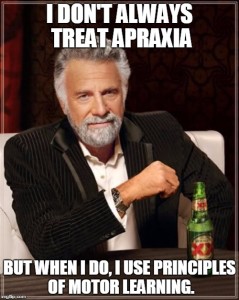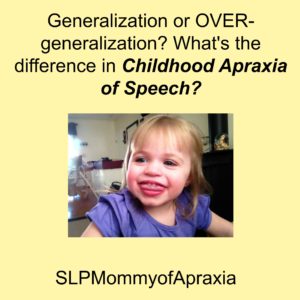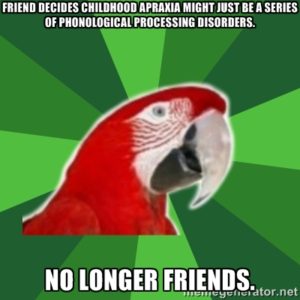Overgeneralization: a caution for clients with CAS
Before I knew my daughter Ashlynn had CAS, and before I spent countless hours researching, taking trainings, and becoming an expert in CAS; I was an elementary school SLP. Like any new SLP, I was relatively inexperienced with CAS. One year, I transferred schools and a 3rd grade boy with a dx of CAS popped up on my caseload. Most people, including his mother, still found him very hard to understand. In her defense, it didn’t help that her first language was Spanish, and this boy only spoke English (apraxic English, you can say).
Anyway, I could understand him most of the time, but his errors were bizarre. He had an /l/ substitution EVERYWHERE, but mostly for sounds he had not yet acquired including /r/ and /th/. Some examples: (blown/brown, muller/mother, bruller/brother).
This was my first experience with “over-generalization” and it’s potential to have a negative lasting impact on kids with CAS.
It was not my first experience though with over-generalization. In kids with phonological disorder, this will happen occasionally. For example, we might be focused on a pattern, let’s say, /s/ blends. A child with a phono disorder will usually omit the /s/ in an /s/ consonant cluster. One of my mentors used this example:
“I see a star in the sky” would be “I tee a tar in the tye.” There are a few phono processes going on here, but suffice it to say, the child is still omitting the /s/ which would be considered a consonant cluster reduction.
When we start targeting /s/ blends, the child will usually (temporarily), start adding an /s/ before every sound. Soon after they learn the pattern without any real long term consequence to existing speech patterns. This is generally regarded a positive sign with phonological disorder, because the child is showing they are making system-wide changes that are generalizing.
This is NOT necessarily true if a child has a dx of CAS. Over-generalization can cause havoc on an already faulty motoric system. There is a limited research I found regarding this phenomenon; however, there is some in the adult literature regarding acquired apraxia of speech (AOS). Wambaugh et.al. (1999) found that in adults with apraxia, sound production training did yield system-wide positive changes in the acquisition of a sound; however, overall maintenance effects exhibited declines in sound production accuracy (intelligibility). The authors concluded this decline was directly attributed to over-generalization of the taught target sound. They recommended using multiple sound targets to increase variability and stabilization during training.
I have searched for more research articles on the subject but have come up empty. This is NOT to say; however, that it is not a common occurrence. Research in the field of communication disorders isn’t exactly robust like it is in the medical field. Even the research we have on apraxia, though more than it was, rarely meets the criteria for the highest level of evidence to be proven effective. Many times we have to go on our clinical experience, and in treating kids with CAS, I have now seen plenty of cases of over-generalization directly caused by the current therapeutic approach. Of course, questions like these usually lead to one pursuing a doctorate and doing a research study….but……that is for another time. lol
I do feel though I need to write on the topic. So here it is.
Therapy for apraxia needs to include many target sounds, sound placements, and syllable shapes. This is very different from many (most) treatment approaches for other speech sound disorders. Let me give you some examples.
In articulation approaches, therapy focuses on one sound. They work to get accuracy and generalization for that particular sound in many different places of words: initial, medial, and final. Therapy then progresses from word, to phrase, to sentence, to conversation.
In phonologic approaches, therapy focuses on patterns of errors. For example, in a popular Cycles approach, kids consistently may delete final consonants (ca/cat, do/dog) or leave off consonant clusters (tar/star, no/snow), to name a few. Therapy would then focus on including final consonants, or consonant clusters.
These are common approaches to most speech sound disorders. These are what most SLP’s will have experience with. They will have seen these in their internships. It’s no surprise then when we fall back on these therapies.
However, this WILL not do for apraxia. Let me give you many personal examples I have now seen in my experience.
For my first example, let’s go back to my 3rd grade boy with crazy /l/ substitutions. Recall he had a history of apraxia and when I met him he was substituting /l/ for sounds he had not yet acquired (r, th). If you are an SLP, you will know this is a pretty unusual error. It was also an error that, at the time, before I knew motor learning principles, I had an INCREDIBLE difficult time extinguishing. I can’t help but wonder (actually I’m really sure now), that the child had fairly good apraxia therapy, and probably was working on /l/. At younger ages, we typically don’t work on later developing sounds such as /th/ and /r/. However, he overgeneralized ALL of his errors to mean he needed to produce an /l/ and there I met him in 3rd grade, and what I saw was a child now saying /l/ for every sound he still had in error.
My second example is a child who has a TON of language, but who is severely apraxic. Unlike my daughter, he can tell stories for hours, but the sounds are completely muddled, jumbled, and in no sensible order. At the word level he would remember to include final consonants, but at the conversational level all of his final consonants were omitted. I am working with his school SLP who is amazing, and she noticed this pattern (phonological disorders and apraxia CAN co-exist), and decided to remediate it. She remediated it SO well, he was adding final consonant sounds to syllables and/or words he had previously mastered that DID NOT have a final consonant. One phone call revealed the error, and we both worked feverishly to rid him of this overgeneralization pattern. We were able to do it, but only after using principles of motor learning. Had she not been so open, there is not doubt in my mind he would still be adding these final consonants to every word. Much like my first example, established motor plans in a child with apraxia is VERY hard to extinguish.
My third example includes a child I started seeing in the very early stages. Though she was able to say many early developing sounds in isolation, she had extreme difficulty sequencing them correctly at the word level. I was seeing her along with another private SLP and school SLP. Early on, she made incredible progress. The other SLP’s were using Kaufman cards, and the first set of Kaufman cards account for all the variables I mentioned above: varying sounds, sound positions, and syllable shapes. When you are dealing with a motor planning disorder, a “sequencing” disorder, these three things are very important. In fact, Nancy Kaufman herself describes her method on her website as:
This is performed through using cues, fading cues, using powerful and strategic reinforcement (motor learning principles), errorless teaching (cueing before failure), gaining many responses within a session, and mixing in varying tasks to avoid over generalization.
Only problem with example number 3 is that she progressed beyond the level 1 cards and so the SLP defaulted on what she knows. This client wasn’t producing any fricatives (s, f, sh) so she started with the fricative (/f/) and starting hitting it hard. The result? My shared client is now using this taught phoneme for all other current fricatives and errored phonemes, and getting her to eliminate this now very strong motor plan is taking longer than expected. What SHOULD have happened is that we target all fricatives now (a variety of sounds) in all word positions and stimulable syllable shapes, STILL using the principles of motor learning theory.
Overgeneralization. It’s a PROBLEM in CAS. If you are an SLP and you start seeing this, you need to look at what you need to change. It’s not a positive indicator like it is for phonological disorder. You are literally carving incorrect motor plans. Remember, we cannot focus on a single sound. We cannot focus on a single pattern. We cannot focus on a single word position. We cannot focus on a single syllable shape. We have to choose targets that are variating ALL of the above that are including sounds within a child’s repertoire. If we don’t, we are going to have a kid with apraxia overgeneralize what we have taught them, and it’s going to cause havoc on their motor system, and potentially make them even less intelligible.
In addition, you will always hear me talk about wasting TIME. Time is so, SO precious to a parent with apraxia, more specifically, getting a child to improve as quickly as possible.
This is ALSO why it’s SO important that even after a child has resolved, a dx of CAS always be included in the case history, because principles of motor learning theory are still the most effective in driving treatment. This is true even when you have moved on to grammar or additional language targets. Apraxia is a different monster. Educate yourself. Learn more. Vist apraxia-kids.org.
Resources:
Wambaugh, J. L., Martinez, A. L., McNeil, M. R., & Rogers, M. A. (1999). Sound production treatment for apraxia of speech: Overgeneralization and maintenance effects. Aphasiology, 13(9-11), 821-837.

